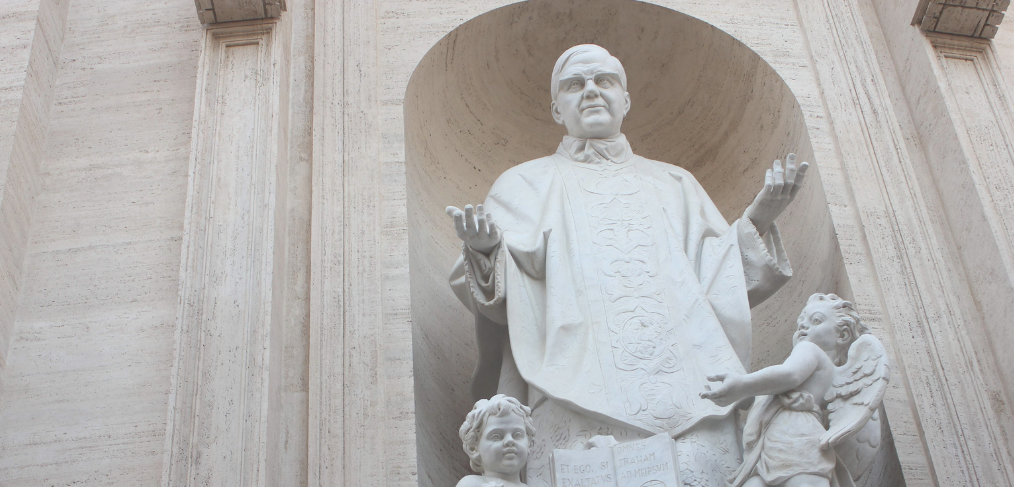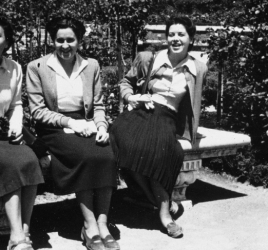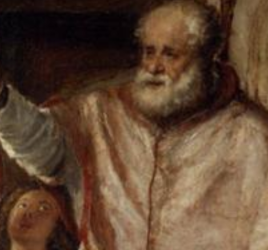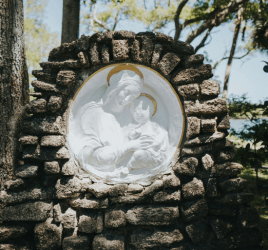
“A Dialogue”: The Statue of St. Josemaria in St. Peter’s Basilica (2005-2025)
“I would like those who in the future look at this statue to feel themselves involved in this dialogue, in this conversation with God and with men – a conversation in which St. Josemaria also takes part, by interceding for us.”
– Romano Cosci
On September 14, 2005, Pope Benedict XVI unveiled and blessed the statue of St. Josemaria Escriva in St. Peter’s Basilica. Two decades later, the statue continues to stand as a powerful witness to the founder of Opus Dei’s message and mission in the life of the Church.
The installation of St. Josemaria’s likeness marked a historic moment: the first major statue added to St. Peter’s Basilica in the new millennium, joining more than 150 depictions of saints who embody the Church’s universal story of holiness. Canonized just three years earlier by Pope St. John Paul II, St. Josemaria was placed prominently in a vaulted niche on the left transept of St. Peter’s Basilica, called the “arm of St. Joseph.” St. John Paul II had designated this section of the basilica for saints and founders of our era, underscoring the enduring relevance of their witness.
A Monument of Scale and Symbolism
Standing slightly over 17 feet St. Josemaria known to date. Carved from a flawless singular block of white Carrara marble in accordance with traditional specifications for St. Peter’s Basilica, the sculpture includes two angels at the saint’s feet. They hold open a Gospel page inscribed with Christ’s words from John 12:32, “And I, when I am lifted up from the earth, shall draw all men to myself.”
The work was entrusted to Romano Cosci, a master sculptor from Pietrasanta in Tuscany, whose artistic tradition reaches back to Michelangelo. Between 2003 and 2005, Cosci transformed sketches and clay models into marble, ultimately overseeing the statue’s transfer to Rome and its installation just days before its blessing.
The Day of Dedication
The blessing ceremony on September 14, 2005, drew nearly a thousand people, among them the Prelate of Opus Dei, Bishop Javier Echevarría. Pope Benedict XVI blessed the statue praying, “O God, who has chosen, in the Church, St. Josemaria, priest, to proclaim the universal call to sanctity and the apostolate, pour your blessing upon this statue and let all of those who see it be inspired to faithfully fulfill their daily work in the spirit of Christ and to serve with ardent love the work of the redemption. Through Christ our Lord.”
The Holy Father paused in prayer beneath the statue, greeted the faithful, and offered personal congratulations to the sculptor.
The Artist’s Reflection
Looking back, Cosci described wanting to not merely reproduce the likeness of St. Josemaria but to invite dialogue, a conversation with God, humanity, and the saint himself. Cosci remarked, “I am happy to be here today, and in particular I find it moving to be so close to the Holy Father, Benedict XVI. I worked for two years on this sculpture, so for me it is a very special moment. When the statue was finally finished, I felt something similar to what a father feels on the day when, after spending years raising a son, he sees him finally set off on his own.
In this statue I wanted to leave something of my own, something very personal to me, something that went beyond just a style or a part of my soul, of my soul as an artist, which as those who are acquainted with me know, seeks the meaning of faith as a path and as a dialogue. Therefore, I would like those who in the future look at this statue to feel themselves involved in this dialogue, in this conversation with God and with men – a conversation in which St. Josemaria also takes part, by interceding for us.
St. Josemaria’s lively look and his hands that are so expressive, were to be in my plan, the means of this dialogue. But in reality, the whole ensemble is involved. It also includes the two angels I placed at the feet of the saint, one at the right and the other at the left, which reflects the equilibrium, serenity and peace that marks the saints.
I asked St. Josemaria for help during the execution of the statue, and he certainly helped me. I am also grateful for the encouragement of the Prelate and the advice of the architect Javier Cotelo and the engineer Fernando Valenciano. I recall, for example, that one day I fell off the scaffolding and hit my head. I ended up in the hospital, but thanks to God (and in my own opinion, to St. Josemaria), I didn’t suffer any major injury.
Otherwise, as I always do, I tried to get to know St. Josemaria well, his life and his teachings, to interiorize his image before beginning to sculpt it. For me this has been a great experience. I hope the statue that I’ve sculpted will transmit at least a part of what he has given to me and what in reality he has given to all of us.
Therefore, I am very grateful to St. Josemaria. This statue is, of course, my work. It is the fruit of my responsibility as an artist. But I think I can also say that this statue has made St. Josemaria a father to me.”
His testimony revealed the depth of his artistic and spiritual investment: from studying the saint’s life and teachings, to seeking his intercession during the work, to surviving a dangerous fall he attributed to St. Josemaria’s protection.
Two Decades of Witness
Twenty years later, the statue remains more than marble. It is a reminder of St. Josemaria’s enduring message that holiness is not reserved for a few, but is a universal calling, lived out in the ordinary duties of daily life.
As pilgrims and visitors continue to pass through St. Peter’s Basilica, the gaze of St. Josemaria carved in stone offers a living invitation: to sanctify work, to seek God in the everyday, and to recognize that the call to holiness resounds in every age, including our own.
Reference: https://opusdei.org/en-sg/article/this-statue-has-made-st-josemaria-a-father-to-me/




